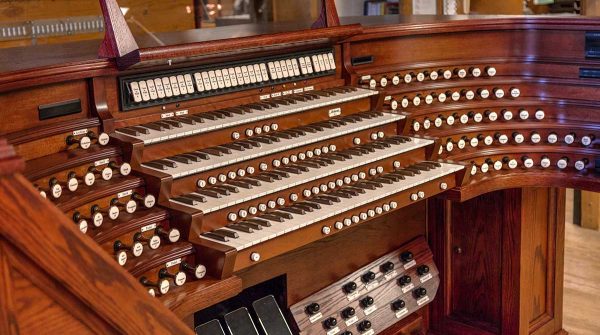Electricity in Organs is one of the most innovative technologies to ever happen to organists in the modern day. It allows the organist many opportunities for improvement in both the ability to practice and in the ability to perform.
There are a few terms that the reader should know. An organ’s ”bellows” are similar to that of a bellow with which you would fan a flame in a fireplace. These bellows produce wind to follow through the wind trunks, which are pipes for the air to go through, to arrive at the pipes to produce the sound we hear. The next term is ”stops” which are the individual sounds that can be combined to make the ”normal” sound of an organ. The keyboards of an organ have a ”pluck” which is a slight resistance in the movement of the key from the normal position to the depressed position. This resistance is the opening of a passageway that the air follows to reach the intended pipe to make the harmony or melodic line desired.

Before electricity’s use in organs, an organist would practice by use of one of 2 methods. First is hiring a person or two (or as required) to pump the bellows of the organ to supply wind for the pipes to speak/make a sound. This method of practice was not the most desirable as you would have to pay the so-called, bellow treader(s) to pump the bellows and also as a result of practicing in the Church during this time, the organist would have to work in a cold environment or pay for some system of heating in the building. The other style of practice was to use an instrument that did not require winding, such as a harpsichord or clavichord, or could supply wind of its own, such as a harmonium. This style of practicing was better for two reasons; it did not require the hiring of bellow treaders and also would not require additional heating beyond what the home’s normal livable temperature would have been.

While these two styles of practicing allowed for excellent music making during that time and a way for the organist to develop his/her technique, both had their disadvantages: the cost of practice time or not hearing the intended instrument’s sound. With the use of electricity in organs, Organists are now allowed to practice without the aid of bellow treaders by application of electric blowers/heavy duty fans or missing out on the sounds of the organ on which they intend to play.
Just as important is the use of electricity to recall combinations of stops at any point in time to accomplish a specific sound to assist the expression of the music and the organist. The sounds can be anything the organist desires to hear in regards to pitch level and dynamics. Olivier Messiaen used this feature of organs to employ intriguing and distinct colors in his pieces that would have been near impossible to accomplish on an organ that did not have electricity to execute these drastic and pertinent sound changes.
In addition to these improvements with electricity, because of this advancement there allowed enablement of a higher technical facility for organists. The development of direct electric action was the cause of the progress. This action allowed for ease of overcoming the pluck of the palette, allowing the pipe to speak. With this available ease, there was an increase in virtuoso writing for the organ. The ability of the organist before this technology was stunted as the key pressure would have to be overcome with more weight and would, therefore, slow the speed at which organists would tend to play because of physical limitations of the instrument.


Hi Ben,
I enjoyed reading your post! I did not realize that organs had so many electrical components. In fact, in did not really understand how organs worked in producing sound. I like that you filled us in on some key terminology before launching into your discussion. This helped me understand what you were talking about. Also, I liked the picture you included. Is there a video documenting the organ mechanism in action? That would be cool to see. You’re writing style was good overall. It was informative and maybe erring on the formal side. You could make it a little less formal if you wanted, but that’s totally up to you. As far as formatting goes, I liked how you broke up the reading into several small chunks. This made it much easier to digest. Perhaps the brighter colors behind the letters could make it a little tough to read the text. Maybe opt for more muted colors, or just plain white? Either way, I enjoyed your post and learning about the organ.